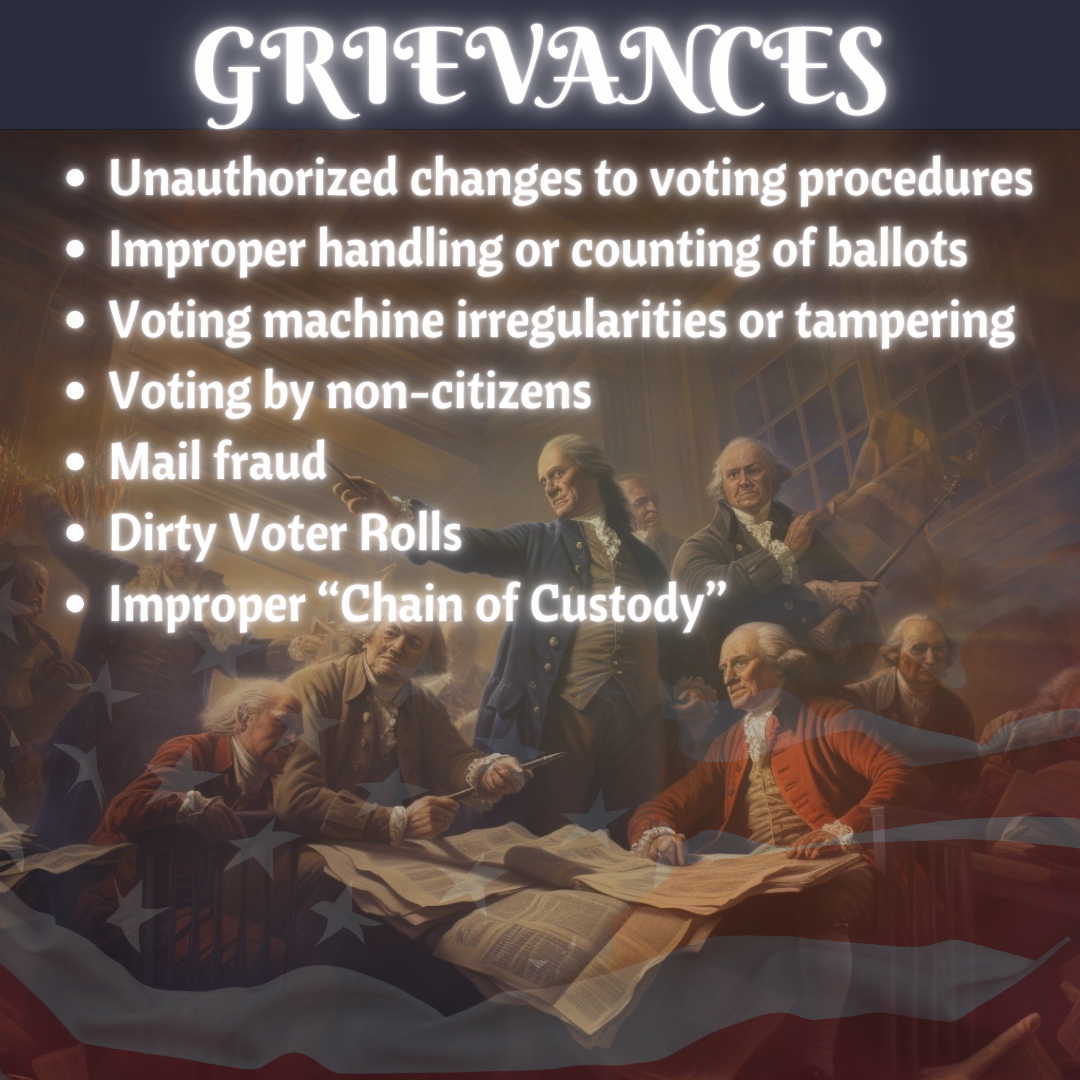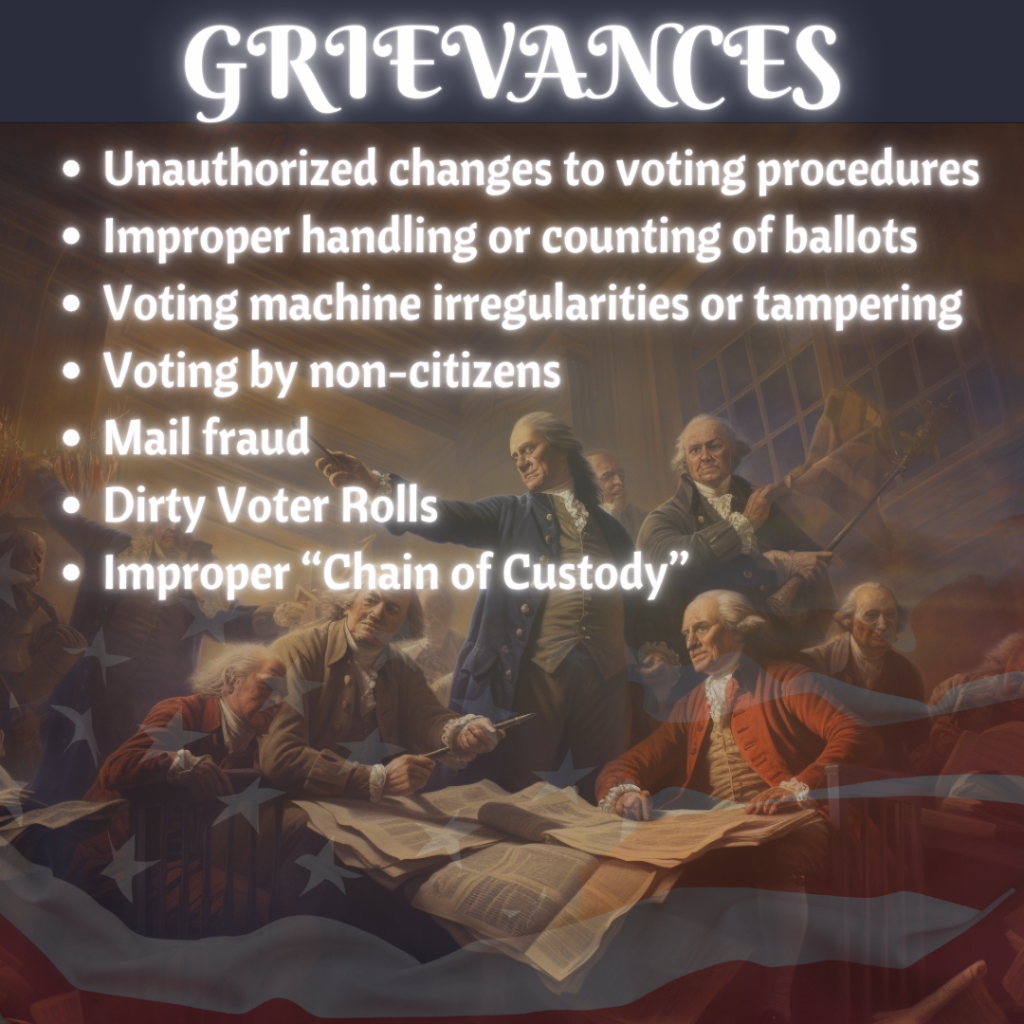CTA – You Have Standing! What Are Your Grievances? #Election2024

This election, put any Fraudulent Action or reports ON Public Record!
Get your grievances on Public Record in your City and County that your rights have been violated. Misty Devenney has provided a Call To Action to counter fraud this election. We can lift a pen to give us Legal Standing with the Courts! Submit your letter anytime before, on or immediately after November 5th as you come across issues.
WE can take ACTION to Give Legal Standing FOR a fair and transparent election:
Take A NOTARIZED letter to YOUR City or County Clerk of Record to put the notarized letter on Public Record.
Direct your letter to your: State legislature; County Election Board; State Supreme Court and to our Federal Congress and Federal Supreme Court.
UPDATE: Do NOT use the word ‘fraud’ in your letter as this legal term is hard to prove in Court!
- Term/phrase to use: ‘maladministration of our election‘
Government Grievance
Writing Template
A grievance letter to the government should be concise, clear, and well-structured. Follow these steps and guidelines to create an effective template:
I. Introduction
- Statement of Grievance: Begin by stating the specific issue or problem you are experiencing, using a simple and declarative sentence. Avoid personal opinions or emotions.
- Background: Provide a brief context for the grievance, including relevant dates, events, and parties involved.
II. Facts and Evidence
- Specific Incidents: Describe the specific incidents or events that led to the grievance, including dates, times, locations, and details of what happened.
- Relevant Documents: Attach or reference relevant documents, such as contracts, policies, or correspondence, that support your claim.
III. Requested Remedy
- Specific Relief: Clearly state what you are requesting as a remedy, such as a correction, reversal, or compensation.
- Rationale: Briefly explain why you believe this remedy is necessary and justified.
IV. Conclusion
- Summary: Summarize the grievance and requested remedy in a few sentences.
- Call to Action: Specify what action you expect the government agency to take to address your grievance.
Certification: I certify that the information provided herein is true and correct to the best of my knowledge.
Signature (in front of notary*):
[Your Name]
*Find a Notary:
- Check with local businesses, such as banks, law firms, and shipping stores, as they may offer notary services.
- ‘Look for online directories, like the American Association of Notaries (AAN) or the National Notary Association (NNA), which allow you to search for notaries by location and specialty.
FOR TWO SAMPLE LETTERS

The More You Know
What is Legal Standing?
Legal standing is a critical concept in US law, ensuring that only those with a direct and substantial interest in the outcome of a case may participate in litigation. A plaintiff must demonstrate injury in fact, causation, and remedy to establish standing, and courts may deny standing in certain situations. Understanding legal standing is essential for navigating the US legal system and ensuring that justice is served.
Legal Standing Definition
Legal standing, also known as locus standi, refers to the capacity of a party to bring a lawsuit in court. It is a fundamental concept in the United States legal system, ensuring that only those with a direct and substantial interest in the outcome of a case may participate in litigation.
Key Elements of Legal Standing
To establish legal standing, a plaintiff must demonstrate:
- Injury in Fact: The plaintiff must have suffered or imminently will suffer a concrete and particularized harm, which is actual or imminent (not conjectural or hypothetical).
- Causation: The plaintiff must show a connection between the defendant’s actions and the plaintiff’s injury.
- Remedy: The court must be able to provide a remedy to the plaintiff, addressing the harm suffered.
Supreme Court Guidance
The Supreme Court has established a three-part test to determine whether a party has standing to sue, as outlined in Lujan v. Defenders of Wildlife (1992):
- Injury in fact
- Causation
- Redressability (the court must be able to provide a remedy)
Exceptions and Limitations
There are situations where courts may deny standing, including:
- Attempting to sue on behalf of a third party injured
- Lack of direct economic interest in a federal contract award
Consequences of Lack of Standing
If a plaintiff lacks standing, the court will dismiss the case, and the plaintiff will be unable to pursue the lawsuit.
Recent Developments
Recent Supreme Court decisions, such as TransUnion v. Ramirez (2021), have highlighted the importance of balancing the need for judicial restraint with the need to protect individual rights. The court’s standing doctrine has been criticized for being overly narrow, potentially closing courthouse doors to legitimate claims.
In Conclusion
Legal standing is a critical concept in US law, ensuring that only those with a direct and substantial interest in the outcome of a case may participate in litigation. A plaintiff must demonstrate injury in fact, causation, and remedy to establish standing, and courts may deny standing in certain situations. Understanding legal standing is essential for navigating the US legal system and ensuring that justice is served.
America Mission & Friends XSpace Schedule

Legal: Disclaimer for America America Mission™ Inc.
**********************************
America Mission on X
****
Remember, it’s
Your Community, Your Town!
****
LinkTree list of Platforms
****
Peruse our collection of videos
on Rumble, Pilled, YouTube, and Kick.
**********************************
Support, Shop,
Amplify Your Voice

Overview of DOGE Cuts for USAID https://x.com/i/grok/share/ddM8dNNeQSj0MFRXGVkpT5m6s
How does the CBO mark up a bill? https://acrobat.adobe.com/id/urn:aaid:sc:US:a5bd04e9-fc70-4bb4-8a6d-6e058810c6f0
https://oversight.house.gov/hearing/public-funds-private-agendas-ngos-gone-wild/
https://oversight.house.gov/hearing/the-federal-government-in-the-age-of-artificial-intelligence/
Do not believe the Medicaid rhetoric https://drive.google.com/file/d/1ynqcypP6USlNI717pnudthWH3FpMkDhe/view?usp=sharing
XSpace 6pm edt 🎙️ https://x.com/i/spaces/1rmGPyNEbymJN
Vote for AM FAFO Act! https://forum.policiesforpeople.com/t/fight-against-federal-overreach-act-fafo-act/26118
This MUST be removed from H.R.1! https://threadreaderapp.com/thread/1930282180812374128.html
Summary of DOGE Cuts for the Office of Management and Budget https://x.com/i/grok/share/7FwaUQph23gddaP3yejtR1SOg






DOGE’s “Wall of Receipts” https://doge.gov/savings